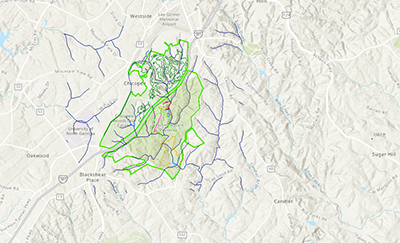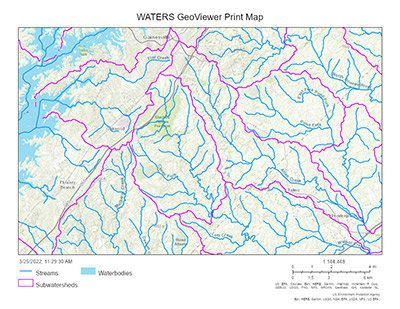A Day in the Life at Chicopee Lake
Editor’s Note: Don Lane, Elachee Teaching Naturalist and retired environmental scientist will provide insight, each month throughout 2022, about different environs and species in, and around Chicopee Lake, located in Georgia’s Chicopee Woods Nature Preserve, in south Hall County.
Don Lane’s Journal Entry: June 2022
How Chicopee Lake and the Chicopee Woods Fit into the Upper Walnut Creek Watershed
I recently had the privilege of teaching a stream ecology program for the spring Master Naturalist course at Elachee. Part of that discussion revolved around watersheds. A watershed is an area of land where all the water drains into a single point or body of water. To better explain where Chicopee Lake and the Chicopee Woods fit in to the bigger watershed, called the Upper Walnut Creek watershed, in this article I reference a couple of exhibits from that class.
Upper Walnut Creek Watershed and Chicopee Lake Watershed


Comparing Figure 1 and Figure 2, we see that Chicopee Woods is high up in the Upper Walnut Creek watershed. Having a green space where there is little human intervention or activity is considered positive. Looking closer at Figure 1 note that, with one exception, each of the streams that provide water to the lake originates outside the boundary of Chicopee Woods. If all these streams originated inside the boundary, it would be expected that the water quality of the lake to be good.
Historically, there has not been a significant amount of water quality testing conducted in the Chicopee Lake watershed by any private or governmental agency. However, in the early 2000’s, the state assessed Walnut Creek and determined it was “impaired.” Under the Clean Water Act, listing a body of water as impaired means it is not meeting its “designated use(s).” The impairment is listed as “biological.” There are two main components of water quality testing: chemical and biological.
Chemical testing involves analyzing water samples to determine if certain chemicals exceed limits mandated by the state and/or the EPA. If one or more chemicals exceed limits, then the body of water is listed as impaired for the chemical(s). The next step is to develop a plan to limit the amount of the chemical(s) that enters the stream.
Biological testing involves gathering “critters” that live in the stream. Some of the critters are more pollution tolerant than others. If there are more pollution tolerant critters than pollution intolerant critters, it suggests that there is some problem. But, if the chemical analysis doesn’t show chemicals out of whack, then all that can be said is that the water body’s biology is not up to snuff, but it is caused by something other than the chemicals analyzed. This appears to be the case with Walnut Creek upstream of Chicopee Lake.
The lake serves the function of a sink. In environmental science, a sink is a repository for something – normally man-made pollution. Another analogy is, “a forest is a sink for carbon.” Some common water pollutants bond to soil particles in the water. As these “contaminated” soil particles reach the still water of the lake, they settle to the bottom. Unlike Buford Dam on Lake Lanier which discharges water from the bottom of the lake, Chicopee Lake’s discharge is designed to drain the top layers of water. One could hypothesize that water from the discharge should be cleaner than the water in the lake because the lake is performing a water treatment function by allowing the contaminated particles to settle to the bottom.
Weather permitting, next month’s blog may test that hypothesis.
Georgia Master Naturalist Program
If you are not familiar with Elachee’s Georgia Master Naturalist program, here is a quick rundown.
The Georgia Master Naturalist program is an adult environmental education course developed by the UGA Warnell School of Forestry and Natural Resources and UGA Cooperative Extension, designed for people who wish to be more informed about habitats, natural resources and the natural environments of our state. The intent of this program is to provide adults unbiased, scientifically accurate information about environmental issues.
In the Elachee program, participants explore local habitats and ecosystems in 10 sessions per semester. The courses combine indoor lectures with outdoor field experiences. Participants receive valuable opportunities to interact with and ask questions of experts in various fields of Georgia ecology, as well as develop new relationships with peers who share the same interests.
Elachee’s Summer/Fall 2022 Master Naturalist Program takes place 1-5 p.m., each Friday, from August 19 to October 21, 2022. Visit https://www.elachee.org/environmental-ed/#master-naturalist to learn more and to enroll for this course.
After completing this fun and interactive program, Georgia Master Naturalists are encouraged to share their knowledge with their communities by volunteering in local schools or nature centers. An informed person can help make changes in their lives as well as their community and safeguard the environment.
